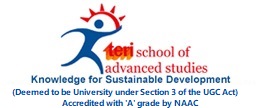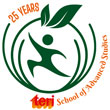
ANNOUNCEMENTS

| Date | News Title | Source |
| 18-July-2025 | 1 in 4 Indian married couples ... | The Indian Express |
| 23-June-2025 | Blended Learning: Driving educ... | The Pioneer |
| 22-June-2025 | All adults overweight in every... | |
| 21-June-2025 | TERI SAS Nurturing Global Sust... | The Interview World (Online) |
| 27-May-2025 | Eco-education trend grows: Sus... | India Today (Online- Education Desk) |
| 25-March-2025 | How water green credits can fu... | Hindustan Times (Opinion) |
| 23-February-2025 | Sustainable biz practices disc... | The Times of India (Online) |
| 21-February-2025 | Sangam fit for bath’, Enviro... | News9 (Online) |
| 12-February-2025 | A role for India in South-Sout... | The Hindu (Online) |
| 02-December-2024 | ICAR Findings Show 34% Decline... | ETV Bharat (Online) |
An interim report by TERI School of Advanced Studies has recommended a range of sustainable solutions to conserve rainwater and prevent urban flooding of the Golf Course Road (GCR) and neighbouring localities. The measures include building recharge wells along the length of the Wazirabad bundh, establishing green corridors along existing drainage channels and reviving naturally existing catchment areas to hold water run-off during monsoon.
TERI’s study was undertaken in the wake of unprecedented waterlogging in Gurugram on August 19, during which GCR was among the worst-affected areas. Titled “Blue Green interventions for addressing flooding along Golf Course Road and Neighbouring Sectors in Gurugram”, TERI’s study “investigates the causes of frequent flooding along Golf Course Road and the neighbouring sectors (26-56)”.
Commissioned by IAmGurgaon — a city-based NGO behind eco-restoration projects such the Aravalli Biodiversity Park and the Wazirabad bundh — TERI’s study has also received the support of officials in the Gurugram Metropolitan Development Authority (GMDA) and the Municipal Corporation of Gurugram (MCG).
Before the study, representatives from TERI and IAmGurgaon held meetings and conducted field visits with VS Kundu, chief executive officer, GMDA and Vinay Pratap Singh, commissioner, MCG, to discuss the scope of the undertaking. The study has not been funded by either of these local bodies, although both received copies of the interim report on November 17.
Kundu and Singh did not respond to requests for comment on Wednesday. However, a senior official in the GMDA’s infrastructure department, who is privy to the matter, said on the condition of anonymity, “We have had a cursory look at the report and are in agreement with the suggestions. Similar conclusions were made by the GMDA’s flood protection committee constituted after August 19, which is headed by HSVP’s former chief engineer KK Bhugra.”
The report (a copy of which is also with HT) has two major areas of focus. The first is an assessment of four drainage channels that originate in the Aravallis just above the Golf Course Road, and traverse its carriageway before draining into a water body that collects along the nearby Chakkarpur-Wazirabad bundh. The first of these natural creeks, which is also the lowest lying, runs through Sector 26, while the other three are located in sectors 42, 54 and 56. These are classified as Creeks 1-4, respectively.
Researchers from the School of Regional Water Studies at TERI-SAS conducted rainfall analysis, land-use mapping and run-off analyses in the project area, based on which they have proposed interventions to be undertaken along each of these four drains. As per the report, “Construction in the area gathered momentum in the last few years and some stretches of the creeks (specifically Creek 2) are found to be not fully functional.”
To revive these drains, a series of nine rain gardens have been proposed to be built at the project site. These would involve planting native vegetation in naturally occurring depressions and low-lying areas to promote groundwater recharge and hold run-off from nearby roads and pavements. Of these, one rain garden has been proposed in Sector 26, three in Sector 42-43, two along the Sector 54 creek and three more along the Sector 56 creek.
The report also recommends the revival of eight naturally existing catchment basins in the Aravalli foothills. Lying upstream from the Golf Course Road, these ponds can be used as storage points to hold the run-off before it reaches GCR. Researchers have further suggested that “the downstream portion of Creek 4 beyond Golf course road needs to be protected as a green corridor.”
It has also recommended that these four creeks be widened and maintained as open, earthen drains. Conducting “soil enhancement” along these networks, the report suggests, would result in a higher “infiltration rate” and promote groundwater recharge.
“It is important to note that these interventions have been made on the assumption of land availability, based on what GIS maps have shown. The report is only an interim one and the feasibility of these interventions will need further assessment. We have also yet to determine the carrying capacity of these four creeks, and a hydrogeology profile of underlying rock layers also needs to be studied. Our final report is still being prepared and will address some of these concerns,” said Dr Fauzia Tarannum, of the School of Regional Water Studies, TERI-SAS.
Other than revival of these creeks, the other major intervention proposed by TERI-SAS includes the construction of 14 recharge wells — known as injection wells — along the length of the Wazirabad bundh, which is where water run-off collects. TERI’s interim report states, “On the Chakkarpur-Wazirabad Main Bund, recharge wells... parallel to the bund is suggested, with infiltration galleries (so that water reaches these wells). These recharge wells can be at points where the creeks join the Bund.”
Researchers at TERI-SAS have also suggested that existing borewell locations in the study area be identified, which will help in determining the aquifer line, along the Chakkarpur Wazirabad bundh. At these locations, “large diameter shallow recharge wells” are suggested. “These well would explicitly facilitate groundwater recharge in the area, which is needed, given how the groundwater table has depleted in recent years. This is a more sustainable option than simply draining the water out,” said Tarannum, who is also an advisor with the district administration’s Gurujal society.
A spokesperson for DLF Estate Developers Ltd, the private developer who is the custodian of GCR, said, “We are aware of the report’s findings and will work with the GMDA and other authorities to resolve this issue. We have already taken stock of the flooding situation that happened earlier in August, which was caused due to unprecedented rainfall and not any infrastructure deficiency. We will consider any suggestions that is in the interest of Gurgaon and its residents.”
Plot No. 10, Institutional Area, Vasant Kunj, New Delhi - 110 070, India.
Tel. +91 11 71800222 (25 lines).
Website : www.terisas.ac.in
Email id : registrar@terisas.ac.in
© Copyright © 2025, TERI SAS, All rights reserved.
Visitors No.: 46570965 Since 2023


